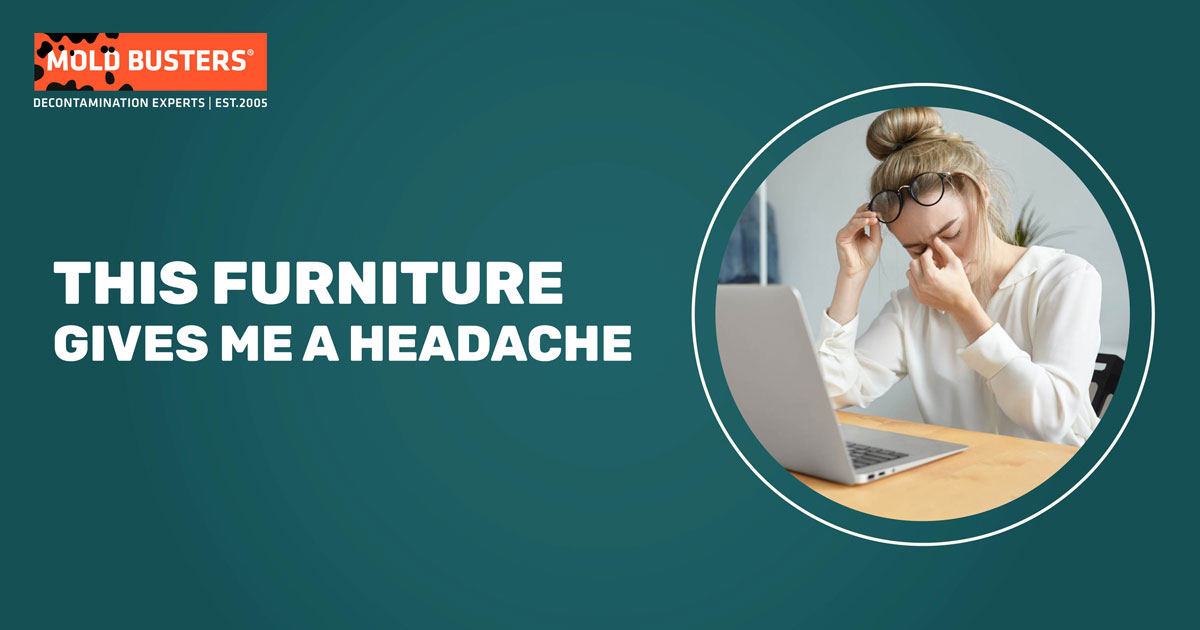This Furniture Gives Me a Headache
Client: Michelle from Carp, ON
Problem: Michelle called Mold Busters to help with pinpointing a mysterious odor. She wondered if a virtual inspection would be needed, but decided to schedule one of our technicians for an on-site diagnostic assessment. “I can barely stay in there for more than 10 minutes without getting a massive headache”, she said. She indicated that the room had no history of water intrusions, there were no carpets, and all recent painting was done with a no-VOC product. At her wits end, she reached out and scheduled one of our technicians to conduct an unbiased diagnostic assessment.
Solution: We arrived at the stunning home near Carp, Ontario, one of the areas covered by our Ottawa mold services, and conducted an exterior inspection, looking at the eavestroughs, shingles, and grading. Everything was normal!
Once inside, Michelle directed us to her picture-perfect home office, where a strong odor was definitely present. Our technician began to measure the humidity levels, moisture content, solid airborne particles, and CO2 – all of which yielded normal to ideal levels. An infrared scan of the exterior walls, ceiling, and windows revealed no active anomalies. With all diagnostics normal, and no visible signs of compromise, the source of this powerful odor was beginning to confound our technician. The odor was so strong, it was beginning to give our technician a headache and he had to put on his face respirator to continue with the inspection.
Finally, the culprit was identified as CH20 emissions from the new carpet, chair, desk, and book shelves – all recently purchased from a build-it-yourself furniture store specifically for this office.
Worried About Hidden Mold? Get a Free Inspection!
Unseen mold can cause health issues like headaches and respiratory problems. Don’t let it go unchecked! Contact Mold Busters for a free virtual mold inspection. Our experts provide comprehensive assessments and solutions to keep your home safe and healthy. Act now to ensure a mold-free environment!
What is Formaldehyde?
According to the National Cancer Institute, formaldehyde is a colorless, flammable, strong-smelling chemical that is used in building materials and to produce many household products. It is used in pressed-wood products, such as particleboard, plywood, and fiberboard; glues and adhesives; permanent-press fabrics; paper product coatings; and certain insulation materials.
Materials containing formaldehyde can release formaldehyde gas or vapor into the air. Exposure occurs primarily by inhaling formaldehyde gas or vapor from the air or by absorbing liquids containing formaldehyde through the skin.
When formaldehyde is present in the air at levels exceeding 0.1 ppm, some individuals may experience adverse effects such as watery eyes; burning sensations in the eyes, nose, and throat; coughing; wheezing; nausea; and skin irritation.
Some people are very sensitive to formaldehyde, whereas others have no reaction to the same level of exposure.
(Source)
Now that we were able to identify the source of Michelle’s odor issues in her office, we were able to recommend a more comprehensive testing strategy that would help generate a detailed report of these diagnostic results. This report would help her in next battle with the furniture company!
Fortunately, we were able to diagnose the odor, and put an immediate mechanism in place to control these emissions and prevent them from affecting her health. “The other mold guys” told me I had a hidden mold problem behind my walls, and gave me a $4000 estimate to fix it! Had it been a genuine mold issue, our Montreal mold removal service would’ve been the solution”, she told us.
Michelle was so happy she didn’t trust the “cut of their jib”, and called us for a second opinion. By doing so, we saved her lots of money, and unnecessary headaches (pun intended).

Resource info
Author: John Ward, Mold Busters
Published: November 29, 2017
Updated: July 7, 2024
